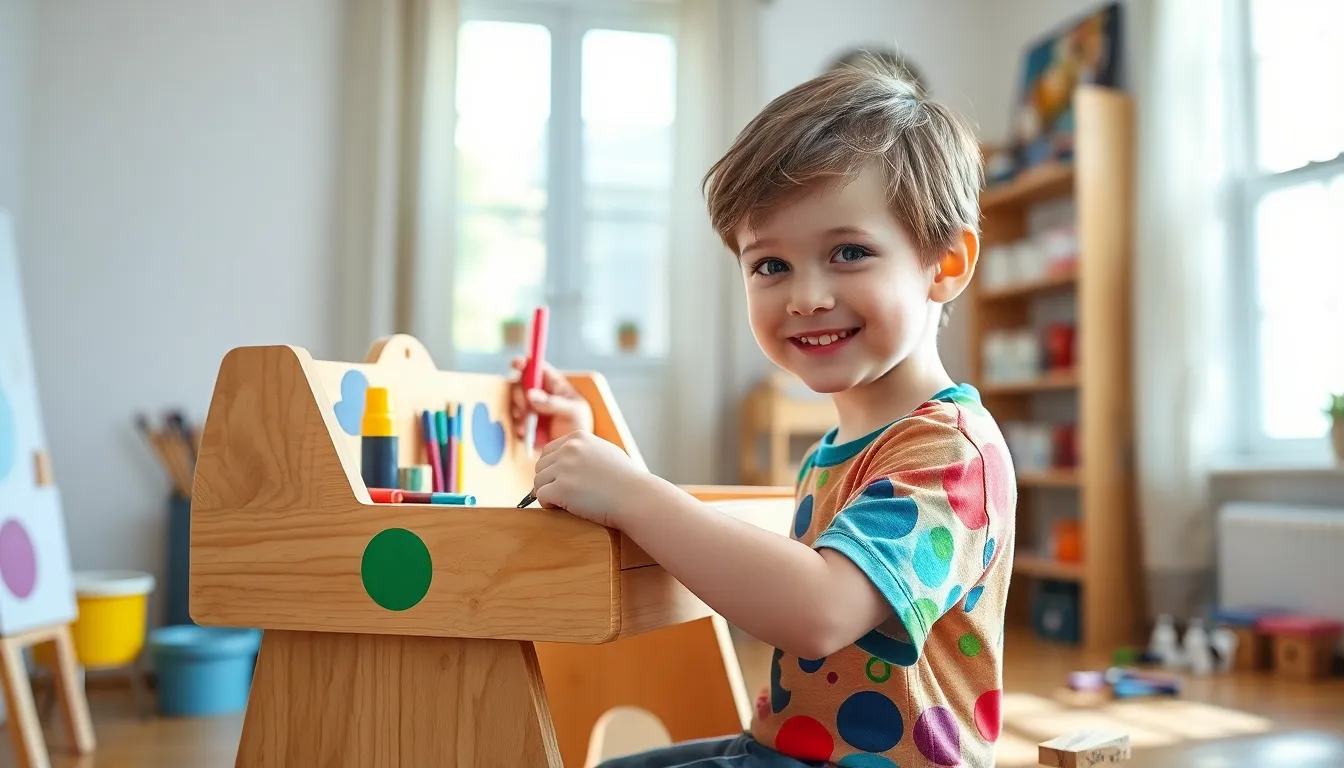Table of Contents
ToggleEvery kid needs a special space to unleash their creativity and tackle homework like a mini superhero. A DIY kids desk isn’t just furniture; it’s a launching pad for imagination, a fortress of solitude for studying, and a stage for the next great art masterpiece. Plus, who wouldn’t want to transform their living room into a mini workshop filled with glitter, glue, and the occasional crayon explosion?
Building a kids desk can be a fun project that brings parents and children together. It’s a chance to bond while crafting something unique that fits perfectly in your home. With a little creativity and some basic tools, you can create a desk that’s not only functional but also reflects your child’s personality. So roll up those sleeves and get ready to create a desk that’ll have your little one saying, “I love homework!” (Well, almost).
Overview of DIY Kids Desks
Creating a DIY kids desk serves several purposes beyond providing a surface for homework. Each desk acts as a personal space where children can unleash their creativity. Functionality, durability, and style factor into the design, ensuring that it caters to individual needs and preferences. Parents play a crucial role in this process, fostering connections through collaborative projects.
Choosing the right materials is essential. Popular options include wood, which offers sturdiness, and MDF, known for its cost-effectiveness. Paints and finishes can enhance the visual appeal, allowing children to customize their desks to fit their personalities. Measurement accuracy remains critical, as a well-sized desk promotes comfort and efficiency.
Designs can vary widely. Simple designs might include straight lines and basic shapes, while more complex styles could incorporate storage solutions like shelves or drawers. The addition of fun elements, such as bright colors or unique hardware, can further engage children in their workspace. Customization allows the desk to grow with the child, adapting to their changing needs over time.
Safety considerations cannot be neglected. Using non-toxic materials helps ensure a safe environment. Smooth edges and sturdy construction prevent accidents, ensuring the desk remains a safe haven for creativity and study. Engaging in this DIY project can lead to a stronger bond between parent and child, reinforcing the desk’s importance as a space that nurtures both learning and imagination.
Benefits of DIY Kids Desks

Creating a DIY kids desk offers numerous advantages that extend beyond mere functionality. This personalized project fosters creativity and provides a budget-friendly solution for parents.
Creativity and Personalization
Encouraging kids to participate in the design process sparks their creativity. A DIY kids desk allows customization, reflecting each child’s unique interests and personality. Children can choose colors, shapes, and layouts that resonate with them, making the desk a personal haven. This hands-on experience instills a sense of pride and ownership, enhancing their connection to the workspace. Personalizing the desk may include adding their favorite themes, drawings, or decorations, further enriching their creative expression. What’s more, the chance to create something together strengthens the bond between parent and child, ensuring that the desk is more than just a study area.
Cost-Effectiveness
Building a DIY kids desk often proves more affordable than purchasing ready-made options. Parents can source materials like sturdy wood or cost-efficient MDF at lower prices, making this project budget-friendly. Creating a customized desk avoids high retail costs while still delivering high quality. Learning to shop wisely for materials enables parents to stretch their budget further. Overall, cost-effectiveness combines with a rewarding building experience, resulting in a functional desk that does not compromise on quality. Parents gain the advantage of saving money while offering their children a personalized workspace, perfect for everyday use.
Materials Needed for DIY Kids Desk
Creating a DIY kids desk requires selecting the right materials for durability and safety. A balanced combination of functionality and aesthetics supports a child’s creative space.
Common Materials
Plywood and solid wood are popular choices, offering strength and stability. MDF stands out as an affordable alternative, providing a smooth finish for easy customization. Screws and wood glue serve as essential fasteners, ensuring a sturdy construction. Sandpaper helps achieve smooth edges, preventing any sharp surfaces during use. Paint or wood stain allows personalization, adding color or design that reflects a child’s personality. A protective sealant can enhance longevity, safeguarding the desk against spills and wear.
Eco-Friendly Options
Reclaimed wood presents an eco-conscious choice, promoting sustainability while adding character to the desk. Bamboo is another green material, known for its rapid growth and strength. Non-toxic paint and finishes ensure a safe workspace, especially for young children. Cork can function as an accent or surface, offering a soft touch while being biodegradable. Fabric scraps can create fun pinboards, adding functionality without harming the environment. By selecting these materials, parents foster a commitment to sustainability while crafting a unique desk for their child’s needs.
Step-by-Step Guide to Building a DIY Kids Desk
Creating a DIY kids desk involves careful planning and execution. Following these steps ensures a successful build, tailored to the child’s needs.
Planning and Design
Designing the desk starts with understanding the child’s requirements. Parents should measure available space and consider the child’s height for optimal comfort. Sketching a design helps visualize the final product, incorporating features like drawers or shelves for organization. Selecting materials is crucial; sturdy wood types ensure longevity. Picking a fun color or theme makes the desk more appealing. Lastly, parents should involve their children in the planning, encouraging them to express their ideas and preferences.
Assembly Instructions
Gather all necessary materials and tools before starting the assembly. Begin with cutting the wood according to the measured dimensions. Using wood glue or screws, join the main structure first, ensuring sturdiness. Attaching the legs securely prevents wobbling during use. If including shelves, add them after the frame is assembled. Ensure every connection is tight to guarantee safety. Sanding sharp edges provides a smooth finish, preventing injuries. Lastly, checking the stability of the desk is essential before moving on to the next phase.
Finishing Touches
Finishing touches enhance the desk’s overall appearance and safety. Applying a non-toxic wood stain or paint gives it a personalized look while protecting the surface. Choosing hardware like knobs or handles adds functionality and style. Personalizing the desk with the child’s name or favorite colors makes it unique. Adding a protective finish prolongs durability, ensuring it withstands daily use. Finally, parents should inspect the desk for any rough spots or sharp edges, creating a safe environment for the child.
Ideas for Customization
Customization options for a DIY kids desk enhance its appeal and functionality. Unique designs reflect children’s personalities and interests.
Paint and Decor
Choosing colors for paint can make a significant impact. Bright shades stimulate creativity, while softer tones promote focus. Adding fun patterns or stencils creates a playful atmosphere. Consider using chalkboard paint on one side, offering a space for doodling or notes. Accessories like stickers can add a personal touch, making the desk feel truly theirs. Fabrics can also play a role; colorful curtains or cushions can complement the desk and create a cohesive look.
Functional Additions
Incorporating storage solutions can maximize the desk’s utility. Built-in shelves or drawer units help keep supplies organized. Clipboards can attach to the wall for easy access to artworks or important papers. Adding a magnetic board provides a place to display creations while saving surface space. Installing a lamp ensures ample lighting, enhancing focus on tasks. With thoughtful functional features, the DIY desk evolves alongside a child’s needs.
Creating a DIY kids desk offers a unique opportunity for parents and children to collaborate on a project that nurtures creativity and learning. This personalized workspace not only enhances a child’s study experience but also fosters a sense of pride and ownership. By selecting the right materials and incorporating thoughtful design elements, parents can craft a desk that adapts to their child’s needs and interests.
The process of building a desk together strengthens family bonds while providing a safe and inspiring environment for imagination. With endless customization options available, a DIY kids desk becomes more than just a piece of furniture; it transforms into a cherished space where creativity thrives and learning flourishes.




